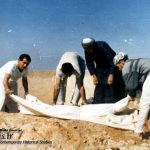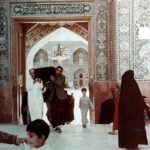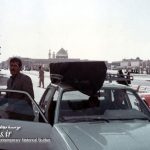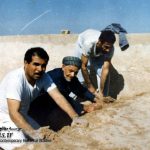The pictures displayed in this post show how a few admirers of Shahīd Sayyid Muahammad Baqir al-Sadr, during the reign of Saddam Hussain, moved his body from Wādī al-Salām in Najaf from a grave that was nearly ruined, to another location. They buried him under a pseudonym. These pictures were released after the fall of Saddam’s regime. Source: Ijtihad Net.
When Ayatullah Sayyid Muhamad Baqir al-Sadr was killed in 1980, his body was buried in Wādī al-Salām secretly. During the 1991 uprising in Iraq, one of Saddam’s men suggested to him that if you want to further avenge the Shi’as, destroy their graves as well. Saddam took this advise and the Iraqi government began to build roads and pathways in the graveyard which resulted in many of the graves being covered and their signs being lost. During this process, the grave of Shahīd Sadr also came in the way of one of these streets being constructed.
During this process, someone who was aware of where the grave of Shahīd Sadr was, tried to ensure that the exact location of his grave remains known. In 1994, after having sought permission from the Marāji’ and the wife of Sayyid Sadr, the individual secretly began attempts to transfer the body of Shahīd from its location. After removing the body of Shahīd Sadr from the grave, they put it on a white car which belonged to the household of Sayyid Husayn Bahr al-‘Ulum and took it to circumambulate around the shrine of Imam ‘Ali (a) three times. After circumambulating the body, they returned it back to Wādī al-Salām and buried it in a location that had been purchased for him.
After some time, a few individuals came to know where the body of Shahīd Sadr was, and this instigated fear in the admirers of the Shahīd. Due to this, they once again secretly decided to transfer the body in 1997 to a location approximately one and a half meters away from its location – seventeen years after his martyrdom while the body still remained in good condition. During this process, they noticed an ‘aqīq ring on his little finger which had a few flowers and the name Muhammad engrave on it.
In Ramaḍan of 1427 hijrī, they once again moved the body to the entrance of the city of Najaf and began to construct an educational and cultural center associated to him. During this transfer process the body was not removed from the grave, rather the whole plot of grave was dug out and moved to its new location.
Sayyid Ali studied in the seminary of Qom from 2012 to 2021, while also concurrently obtaining a M.A in Islamic Studies from the Islamic College of London in 2018. In the seminary he engaged in the study of legal theory, jurisprudence and philosophy, eventually attending the advanced kharij of Usul and Fiqh in 2018. He is currently completing his Masters of Education at the University of Toronto and is the head of a private faith-based school in Toronto, as well as an instructor at the Mizan Institute and Mufid Seminary.
















